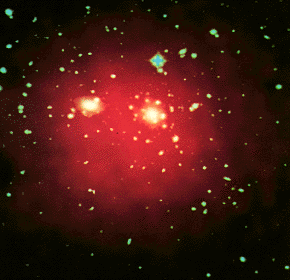The Nature of Dark Matter
In general, scientists learn about the Universe by the electromagnetic radiation (or light) that we can observe emanating from the objects in it. The light we see is in the form of radio waves, infrared, optical, ultraviolet, X-ray, and gamma-ray emission. But what if there is material in the Universe that does not glow in a way that we can directly observe? How will we ever know it is there? How can we tell how much of it there is? How do we know what it is?
Back in 1933, astronomer Fritz Zwicky was studying the Coma Cluster of galaxies, and he noticed that the amount of matter needed to result in the orbital speed of the galaxies did not reflect the amount of matter that was visually detectable. Many more observations with similar characteristics have been made since then, and scientists have used these observations to determine that the gravitational potential required to explain the observations implies a significant amount of what Zwicky termed "missing mass" – something we now commonly refer to as "dark matter."

Astronomers now think that most of the material in the Universe is made of dark matter. It is matter that does not emit sufficient light for us to directly detect it. However, there are a variety of ways that we can indirectly detect it. The most common method involves the fact that the dark matter, like other forms of visible matter, has a gravitational influence on the light and sources of light that we can see. From the effects of "extra" gravity that we detect, we infer how much mass must be present.
The kinds of materials that we experience every day are made of atoms, which are made of protons, neutrons, and electrons. We refer to this type of matter as "baryonic." The foremost question that scientists are working to address is whether dark matter is made of the same stuff that we are familiar with, i.e., is it baryonic, or is it some kind of exotic new material? So far, it appears that there is both baryonic and non-baryonic dark matter, and the Universe appears to be composed of both kinds. The scientific realm is still very active in the effort to discover the nature of each variety.
Updated: June 2011


